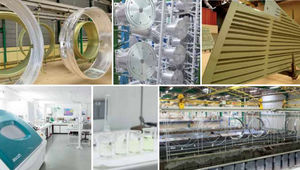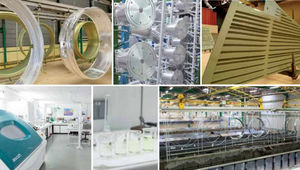
- Products
- SGI - Société de Galvanoplastie Industrielle
Inconel anaphoresis aluminumstainless steeltitanium

Add to favorites
Compare this product
Characteristics
- Substrate
- Inconel, aluminum, stainless steel, titanium
- Applications
- industrial, automotive, for aeronautics, for the aerospace industry, for railway
Description
The process implemented is electro-depositing of paint and consists of submerging the workpiece in a bath of water-based electrically conducting paint.
Description of the process
A potential difference is applied between the part and a counter-electrode by connecting the part to the positive pole (anode, hence the name anaphoresis) and the counter-electrode to the negative pole (cathode). The resulting effect is accompanied by the migration of particles of paint in suspension from the cathode to the anode. These are then deposited uniformly on practically the whole area of the part immersed. The operation only lasts for a few minutes in a continuously stirred bath. The paint is then drained off and polymerized in an oven at a temperature below 120°C.
Appearance: tray grey 707
Thickness: 4 to 30 µm
Surface condition: no impact on roughness
Reduction in the fatigue: No impact, or in all cases lower impact than that observed on the CAO, fine SAO or STA.
Substrates
All conductive materials (titanium alloys, aluminium, Inconel, stainless steel, etc.) and for all modes of transformation.
Applications
Corrosion resistance.
Paint adhesion base.
Simplification of protection plans for aircraft (process 3 in 1)
Economy before hard anodizing.
Sectors concerned: aeronautical, space, automobile, rail, etc.
Catalogs
No catalogs are available for this product.
See all of SGI - Société de Galvanoplastie Industrielle‘s catalogsOther SGI - Société de Galvanoplastie Industrielle products
Treatment by electrolytic conversion
*Prices are pre-tax. They exclude delivery charges and customs duties and do not include additional charges for installation or activation options. Prices are indicative only and may vary by country, with changes to the cost of raw materials and exchange rates.





